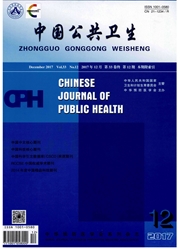

 中文摘要:
中文摘要:
目的 探讨扬沙和沙尘暴细颗粒物(PM2.5)对肺泡巨噬细胞(AM)的毒作用机制。方法于2004年3月采集甘肃省武威市和内蒙古包头市正常天气、扬沙天气和沙尘暴天气中大气PM2.5,并测定其质量浓度。以PM2.5悬液体外处理大鼠肺泡巨噬细胞4h,通过四甲基偶氮噻唑蓝(MTT)法检测细胞存活率、定磷法检测质膜ATP酶活性、2,4-二硝基苯肼法和4-氨基安替比林法检测细胞培养液中乳酸脱氢酶(LDH)活性和酸性磷酸酶(ACP)活性。并以荧光探针1-苯胺基-8-萘磺酸(ANS)和1,6-二苯基-1,3,5-己三烯(DPH)为标记物检测细胞膜脂盼流动性。结果与对照(生理盐水组)相比,扬沙和沙尘暴PM2,样品可剂量依赖性地降低细胞存活率和质膜Ca^2+Mg^2+-ATP酶、Na^+K^+-ATP酶活性、增大细胞膜表层流动性,并使细胞质内LDH和ACP外渗;与正常天气样品相比,对上述指标的影响差异无统计学意义。结论扬沙和沙尘暴PM2.5可影响AM膜通透性和流动性,导致细胞死亡。由于沙尘天气时大气PM2.5质量浓度大大高于正常天气。其对健康危害作用也相应增大。
 英文摘要:
英文摘要:
Objective To investigate the hazards of blowing sand and dust storm fine particulate matter (PM2.5) on rat alveolar macrophage membranes. Methods The ambient PM2.5 samples were collected on normal, blowing sand and dust storm days in Wuwei city, Gansu province and Baotou city, Inner Mongolia Autonomous region. After rat alveolar macrophages(AM) were treated 4 h with particle suspensions of the samples, cytotoxicity was assessed using methyl thiazolyl tetrazolium(MTT) reduction assay. Also, activities of plasma membrane Ca^2+Mg^2+-ATPase and Na^+K^+-ATPase, activties of lactate dehydrogenase (LDH) and acid phosphatese (ACP) in culture meduim, and plasma membrane fluidity were examined. Results Both the blowing sand and dust storm PM2.5 could decrease cell viability, inhibit plasma membrane Ca^2+Mg^2+-ATPase and Na^+K+- ATPase, increase leakage of cytosolic LDH and ACP, and elevate surface fluidity of plasma membranes in a dose-dependent manner as compared with the control saline. And the twoway ANOVA showed there was no significant difference on alterations of the measured indices between normal, blowing sand and dust storm groups. Conclusion Blowing sand and dust storm PM2.5 could make adverse effects on AM by increasing plasma membrane permeability and fluidity, leading to cytotoxicity. It suggested that appropriate attention should be focused on their toxicities.
 同期刊论文项目
同期刊论文项目
 同项目期刊论文
同项目期刊论文
 期刊信息
期刊信息
